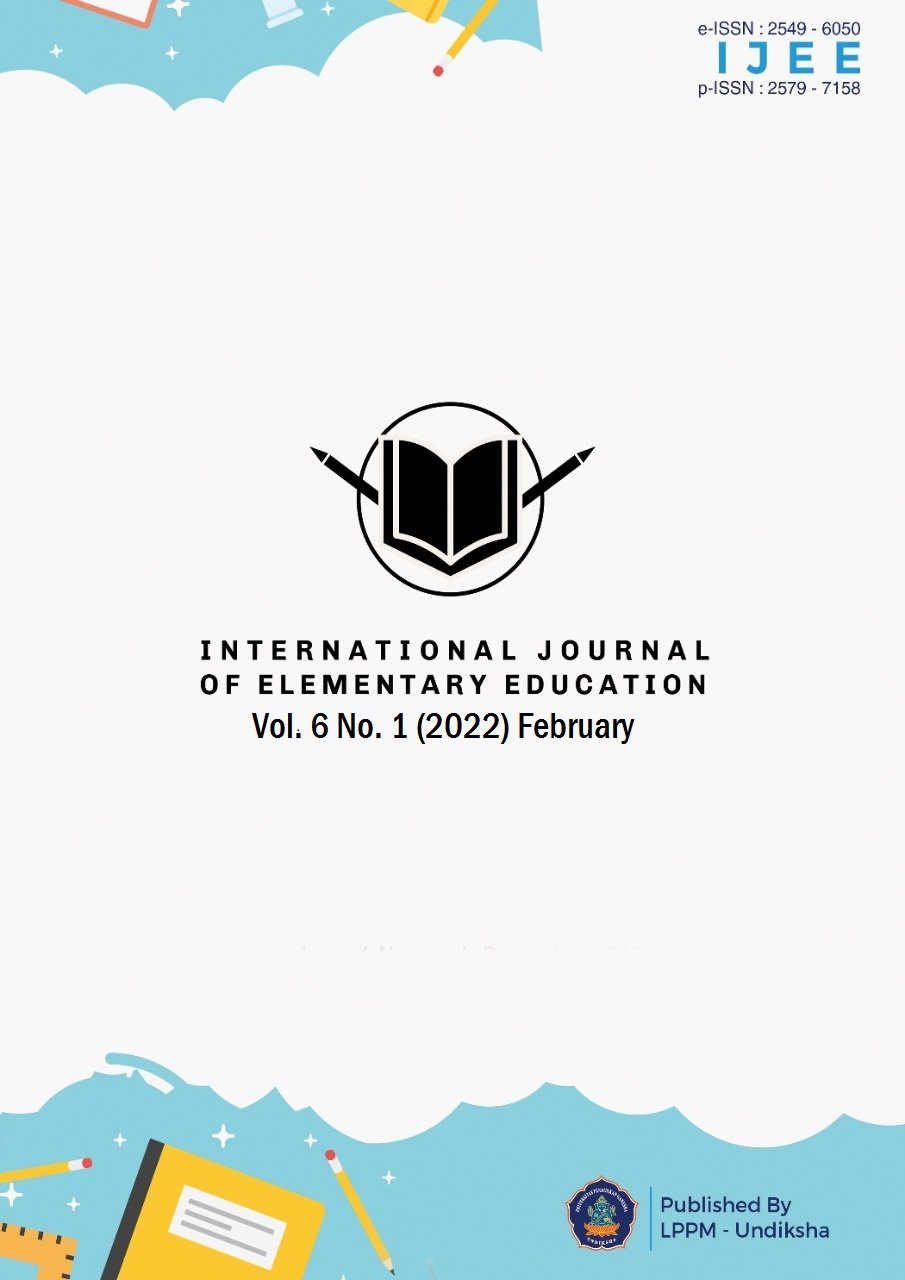Verbal Intelligence: A Key of Students Development
DOI:
https://doi.org/10.23887/ijee.v6i1.43994Keywords:
Verbal Intelligence, Audio-based Stories, Elementary SchoolAbstract
Students in elementary schools often experience various developmental disorders, especially those related to verbal intelligence, so that students experience difficulties in acquiring basic skills such as writing, reading, or speaking. Therefore, it is necessary to analyze to measure the verbal intelligence ability of students from an early age when in elementary school. This study aims to explore the verbal intelligence of students in the overall aspects, namely: reading, writing, listening, and speaking. This research uses descriptive qualitative research with a case study model. In collecting data, the researcher used a tool, namely audio-based stories, then strengthened interviews (unstructured) with educators and students with 25 respondents. Analysis of the data using Miles and Huberman. The study’s overall students' verbal intelligence still must be considered. In general, it is proven that almost half of students still lack in listening, reading, writing, and speaking aspects, so this will certainly hinder the development of students at their age. The implication of this research is the need for support from relevant stakeholders to develop verbal skills from an early age so that it becomes the key to the development of students in the future.References
Anderson, J. A. E., Mak, L., Keyvani Chahi, A., & Bialystok, E. (2018). The language and social background questionnaire: Assessing the degree of bilingualism in a diverse population. Behavior Research Methods, 50(1), 250–263. https://doi.org/10.3758/s13428-017-0867-9.
Atterström, A., Malmqvist, J., Anderberg, E., & Swärd, A.-K. (2021). Experiences about Reading and Writing Development Narrated by Students with Severe Speech and Physical Impairment. International Journal of Disability, Development and Education, 1–19. https://doi.org/10.1080/1034912X.2021.1940880.
Bodin, D., Pardini, D. A., Burns, T. G., & Stevens, A. B. (2009). Higher Order Factor Structure of the WISC-IV in a Clinical Neuropsychological Sample. Child Neuropsychology, 15(5), 417–424. https://doi.org/10.1080/09297040802603661.
Bourdeaud’hui, H., Aesaert, K., van Keer, H., & van Braak, J. (2018). Identifying student and classroom characteristics related to primary school students’ listening skills: A systematic review. Educational Research, 25, 86–99. https://doi.org/10.1016/j.edurev.2018.09.005.
Catalan, A., Salazar de Pablo, G., Aymerich, C., Damiani, S., Sordi, V., Radua, J., Oliver, D., McGuire, P., Giuliano, A. J., Stone, W. S., & Fusar-Poli, P. (2021). Neurocognitive Functioning in Individuals at Clinical High Risk for Psychosis. JAMA Psychiatry, 78(8), 859. https://doi.org/10.1001/jamapsychiatry.2021.1290.
Chau, J. P. C., Lo, S. H. S., Chan, K. M., Chan, M. Y., Lee, V. W. Y., Lam, S. K. Y., Choi, K. C., & Thompson, D. R. (2021). Development and evaluation of a technology-enhanced, enquiry-based learning program on managing neonatal extravasation injury: A pre-test/post-test mixed-methods study. Nurse Education Today, 97, 104672. https://doi.org/10.1016/j.nedt.2020.104672.
de Paola, M., Lombardo, R., Pupo, V., & Scoppa, V. (2021). Do Women Shy Away from Public Speaking? A Field Experiment. Labour Economics, 70, 102001. https://doi.org/10.1016/j.labeco.2021.102001.
Djatmiko, R. D., Wibowo, Y. E., & Marwanto, A. (2020). Linguistic verbal intelligence in welding practice lectures. Journal of Physics: Conference Series, 1700(1), 012026. https://doi.org/10.1088/1742-6596/1700/1/012026.
Eka putri, E. I., Dewi, R., & Wahyono, I. (2020). Implementasi Metode Sentra Persiapan Dalam Mengembangkan Kecerdasan Verbal Linguistik Anak Usia Dini. Tarbiyatuna : Kajian Pendidikan Islam, 4(1), 095. https://doi.org/10.29062/tarbiyatuna.v4i1.298.
Francis, R., Hawes, D. J., Abbott, M. J., & Costa, D. S. J. (2018). Cognitive mechanisms for worry in early adolescence: Re-examining the role of high verbal intelligence. Personality and Individual Differences, 120, 179–184. https://doi.org/10.1016/j.paid.2017.08.044.
Gollan, T. H., Montoya, R. I., & Werner, G. A. (2002). Semantic and letter fluency in Spanish-English bilinguals. Neuropsychology, 16(4), 562–576. https://doi.org/10.1037/0894-4105.16.4.562.
Gong, T., Zhang, M., & Li, C. (2021). Association of keyboarding fluency and writing performance in online-delivered assessment. Assessing Writing, 51, 100575. https://doi.org/10.1016/j.asw.2021.100575
González-Treviño, I. M., Núñez-Rocha, G. M., Valencia-Hernández, J. M., & Arrona-Palacios, A. (2020). Assessment of multiple intelligences in elementary school students in Mexico: An exploratory study. Heliyon, 6(4). https://doi.org/10.1016/j.heliyon.2020.e03777.
Gulec, S., & Durmus, N. (2015). A Study Aiming to Develop Listening Skills of Elementary second Grade Students. Procedia - Social and Behavioral Sciences, 191, 103–109. https://doi.org/10.1016/j.sbspro.2015.04.487.
Halil, N. I. (2017). The Actualization of Literary Learning Model Based on Verbal-Linguistic Intelligence. International Journal of Education and Literacy Studies, 5(4), 42. https://doi.org/10.7575/aiac.ijels.v.5n.4p.42.
Halimah, A., Afiif, A., & Ratu, B. (2018). Pengaruh Kecerdasan Verbal Linguistik Terhadap Hasil Belajar Pada Mata Pelajaran Bahasa Indonesia. AULADUNA: Jurnal Pendidikan Dasar Islam, 5(2), 162. https://doi.org/10.24252/auladuna.v5i2a5.2018.
Hasanudin, C., & Fitrianingsih, A. (2020). Verbal linguistic intelligence of the first-year students of Indonesian education program: A case in reading subject. European Journal of Educational Research, 9(1), 117–128. https://doi.org/10.12973/eu-jer.9.1.117.
Janebi Enayat, M., & Derakhshan, A. (2021). Vocabulary size and depth as predictors of second language speaking ability. System, 99, 102521. https://doi.org/10.1016/j.system.2021.102521.
Jewell, M., Morley, R., & Uhlmann, A. (2019). New writing in an aged care setting. New Writing, 16(2), 206–219. https://doi.org/10.1080/14790726.2018.1490775.
Kim, Y.-S. G., Yang, D., Reyes, M., & Connor, C. (2021). Writing instruction improves students’ writing skills differentially depending on focal instruction and children: A meta-analysis for primary grade students. Educational Research Review, 34, 100408. https://doi.org/10.1016/j.edurev.2021.100408.
Kirom, S. (2019). Peningkatan Kemampuan Menulis Artikel Ilmiah melalui Strategi Pembelajaran Berbasis Kecerdasan Verbal Linguistik. Silampari Bisa: Jurnal Penelitian Pendidikan Bahasa Indonesia, Daerah, Dan Asing, 2(2), 204–226. https://doi.org/10.31540/silamparibisa.v2i2.616.
Kiseleva, N., & Kiselev, S. (2019). Processing speed in 6 year-old children can predict non-verbal intelligence test scores in children at 8 years of age. Journal of the Neurological Sciences, 405, 33. https://doi.org/10.1016/j.jns.2019.10.1609.
Kleemans, T., Segers, E., & Verhoeven, L. (2018). Role of linguistic skills in fifth-grade mathematics. Journal of Experimental Child Psychology, 167, 404–413. https://doi.org/10.1016/j.jecp.2017.11.012.
Klupp, S., Möhring, W., Lemola, S., & Grob, A. (2021). Relations between fine motor skills and intelligence in typically developing children and children with attention deficit hyperactivity disorder. Research in Developmental Disabilities, 110, 103855. https://doi.org/10.1016/j.ridd.2021.103855.
Luo, L., Luk, G., & Bialystok, E. (2010). Effect of language proficiency and executive control on verbal fluency performance in bilinguals. Cognition, 114(1), 29–41. https://doi.org/10.1016/j.cognition.2009.08.014.
Luwel, K., Foustana, A., Onghena, P., & Verschaffel, L. (2013). The role of verbal and performance intelligence in children’s strategy selection and execution. Learning and Individual Differences, 24, 134–138. https://doi.org/10.1016/j.lindif.2013.01.010.
Maagerø, E., Siljan, H., & Veum, A. (2021). Going from oral to written discourse: Norwegian students’ grammatical challenges when writing persuasive texts. Linguistics and Education, 66, 101001. https://doi.org/10.1016/j.linged.2021.101001.
Maamuujav, U., Olson, C. B., & Chung, H. (2021). Syntactic and lexical features of adolescent L2 students’ academic writing. Journal of Second Language Writing, 53, 100822. https://doi.org/10.1016/j.jslw.2021.100822.
Magnusson, D. (1993). Individual development: A holistic, integrated model. Examining Lives in Context: Perspectives on the Ecology of Human Development., 19–60. https://doi.org/10.1037/10176-001.
Merchant, G. (2021). Reading with technology: the new normal. Education 3-13, 49(1), 96–106. https://doi.org/10.1080/03004279.2020.1824705.
Mujiono, M., Nakhrowi, N., & Fatimah, S. (2019). The Effect of Verbal-Linguistic Intelligence and Emotional Intelligence on Academic Achievement of Indonesian EFL Learners. International Journal of Learning, Teaching and Educational Research, 18(12), 350–365. https://doi.org/10.26803/ijlter.18.12.20.
Nikolaev, B., & McGee, J. J. (2016). Relative verbal intelligence and happiness. Intelligence, 59, 1–7. https://doi.org/10.1016/j.intell.2016.09.002.
Nurgiyantoro, B. (2015). Pengkajian Teori Fiksi. UGM Pers.
Nurgiyantoro, B. (2016). Penilaian Pembelajaran Bahasa Berbasis Kompetensi. BPFE-Yogyakarta.
Otten, S., Gilbertson, N. J., Males, L. M., & Clark, D. L. (2014). The Mathematical Nature of Reasoning-and-Proving Opportunities in Geometry Textbooks. Mathematical Thinking and Learning, 16(1), 51–79. https://doi.org/10.1080/10986065.2014.857802.
Pino Escobar, G., Kalashnikova, M., & Escudero, P. (2018). Vocabulary matters! The relationship between verbal fluency and measures of inhibitory control in monolingual and bilingual children. Journal of Experimental Child Psychology, 170, 177–189. https://doi.org/10.1016/j.jecp.2018.01.012.
Rodrigo, V. (2017). Quantifying comprehension gains after repeated listening by students of Spanish with different listening ability: an exploratory study. Journal of Spanish Language Teaching, 4(1), 35–48. https://doi.org/10.1080/23247797.2017.1315260.
Shao, Z., Janse, E., Visser, K., & Meyer, A. S. (2014). What do verbal fluency tasks measure? Predictors of verbal fluency performance in older adults. Frontiers in Psychology, 5. https://doi.org/10.3389/fpsyg.2014.00772.
Shapiro, E. S. (2019). School Psychology from an Instructional Perspective: Solving Big, Not Little Problems. School Psychology Review, 29(4), 560–572. https://doi.org/10.1080/02796015.2000.12086043.
Slamet, S. Y. (2014). Pembelajaran Bahasa dan Sastra Indonesia di Kelas Rendah dan Tinggi Sekolah Dasar. UNS Pers.
Støle, H., Mangen, A., & Schwippert, K. (2020). Assessing children’s reading comprehension on paper and screen: A mode-effect study. Computers & Education, 151, 103861. https://doi.org/10.1016/j.compedu.2020.103861.
Stylianides, G. J., & Stylianides, A. J. (2008). Proof in School Mathematics: Insights from Psychological Research into Students’ Ability for Deductive Reasoning. Mathematical Thinking and Learning, 10(2), 103–133. https://doi.org/10.1080/10986060701854425.
Sullivian, M. D., Poarch, G. J., & Bialystok, E. (2015). Why is lexical retrieval slower for bilinguals? Evidence from picture naming. Bilingualism: Language and Cognition, 21(3), 479–488. https://doi.org/10.1017/S1366728917000694.
Thomson, J. M., Foldnes, N., Uppstad, P. H., Njå, M., Solheim, O. J., & Lundetræ, K. (2020). Can children’s instructional gameplay activity be used as a predictive indicator of reading skills?Title. Learning and Instruction, 68, 101348. https://doi.org/10.1016/j.learninstruc.2020.101348.
van Herwegen, J. (2015). Williams syndrome and its cognitive profile: the importance of eye movements. Psychology Research and Behavior Management, 8, 143. https://doi.org/10.2147/PRBM.S63474.
Wang, H., & Yu, G. (2021). Test-Takers’ Cognitive Processes during a Listen-To-Summarize Cloze Task. International Journal of Listening, 35(1), 1–28. https://doi.org/10.1080/10904018.2018.1473040.
Wilkinson, S. C. (1993). WISC-R Profiles of Children with Superior Intellectual Ability. Gifted Child Quarterly, 37(2), 84–91. https://doi.org/10.1177/001698629303700206.
Yenkimaleki, M., & van Heuven, V. J. (2022). Comparing the nativeness vs. intelligibility approach in prosody instruction for developing speaking skills by interpreter trainees: an experimental study. Speech Communication, 52(4), 367–379. https://doi.org/10.1016/j.specom.2022.01.007.
Yılmaz, H., & Yavuz, F. (2015). The Problems Young Learners Encounter During Listening Skills. Procedia - Social and Behavioral Sciences, 197, 2046–2050. https://doi.org/10.1016/j.sbspro.2015.07.570.
Zeng, Z., Kalashnikova, M., & Antoniou, M. (2019). Integrating Bilingualism, Verbal Fluency, and Executive Functioning across the Lifespan. Journal of Cognition and Development, 20(5), 656–679. https://doi.org/10.1080/15248372.2019.1648267.
Zivan, M., & Horowitz-Kraus, T. (2020). Parent–child joint reading is related to an increased fixation time on print during storytelling among preschool children. Brain and Cognition, 143, 105596. https://doi.org/10.1016/j.bandc.2020.105596.
Downloads
Published
How to Cite
Issue
Section
License
Copyright (c) 2022 Anggita Tiara Dewi, Slamet Subiyantoro, Sarwanto

This work is licensed under a Creative Commons Attribution-ShareAlike 4.0 International License.
Authors who publish with the International Journal of Elementary Education agree to the following terms:
- Authors retain copyright and grant the journal the right of first publication with the work simultaneously licensed under a Creative Commons Attribution License (CC BY-SA 4.0) that allows others to share the work with an acknowledgment of the work's authorship and initial publication in this journal.
- Authors are able to enter into separate, additional contractual arrangements for the non-exclusive distribution of the journal's published version of the work (e.g., post it to an institutional repository or publish it in a book), with an acknowledgment of its initial publication in this journal.
- Authors are permitted and encouraged to post their work online (e.g., in institutional repositories or on their website) prior to and during the submission process, as it can lead to productive exchanges, as well as earlier and greater citation of published work. (See The Effect of Open Access)










